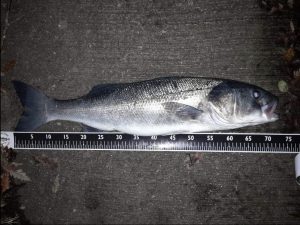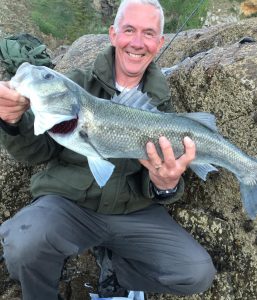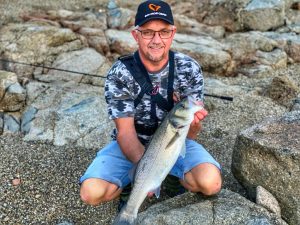In my last blog I spoke about the weather putting the kibosh on the fishing. Well, now that the weather is playing ball, and we have some lovely conditions, the fish seem to have disappeared; such are the frustrations of bass angling!
It’s not quite as bad as that, as you’ll see from my ramblings below, but it certainly feels that way. Not that this is totally unexpected though, going by past catches at this time of year. Is it something to do with migration? Is it something to do with the number of pilchards around? But then that doubt starts to creep in – has the effect of commercial fishing on the bass stocks reached a tipping point?
Netting carnage
I would love to be telling you in my next (January) blog that I’ve had a brilliant end to my bass angling season. But I’m not holding my breath, especially after hearing recent reports of big catches of fish by gillnetters locally.
These fish are aggregating and migrating ahead of overwintering offshore. They follow a well-known path every year, which puts them at the mercy of those who would intercept them for commercial gain. I have nothing against people earning a living, but this mass slaughter seems like crass stupidity to me. Not only is it doing great damage to bass stocks, the flooding of the market that results makes the price obtained go through the floor. If nothing else, please have respect for this noble fish, and don’t reduce it to being sold for pet food.
And aren’t the current bass regs supposed to stop people targeting bass with gillnets anyway? I’ve already written to Cornwall IFCA about this; please do the same. Save Our Sea Bass have all the info here, and have made it easy for you do this. And remember, this isn’t just a Cornish issue – these fish come from far and wide.
I can recall being very depressed each winter by reports of huge catches of bass in the pair trawl fishery. Thankfully this has now been stopped, which shows that things can be improved. But for this improvement to be fully realised and maintained, this annual slaughter of migrating and prespawning fish by gill netters must go the same way. The current ban on all commercial methods of catching bass in February and March must be extended locally for gill netters to cover the peak months (Nov, Dec and Jan for Cornwall). We know that spawning fish are making their way back up the coast in April, so that should be included as well.
A lousy bass
Rob Franklin caught a very nice 74cm bass recently. Going by its length, this fish would have been estimated at 9lb+ using the BASS tape and yet it weighed 7.5lb. This is odd, since bass are usually fattening up at this time of year, and if anything can weigh more than the tape weight suggests.

One possible explanation might be the louse that Rob found on one of the fish’s fins (not visible on the photo above), which looked “like a giant wood lice”. He sent me a photo of one like it:

The Plymouth Marine Laboratory (PML) identified the louse in this photo as belonging to the family Caligidae.
Is it possible that this thing, feeding on the fish’s flesh, could account for the loss of weight? PML think that low numbers of lice are unlikely to cause significant issues to the host, so this seems unlikely.
Rob says that these lice have been found in the mouths and bellies of cod and whiting locally, leading to the conclusion that they have been eating fish with lice attached.
Rob wonders if the presence of these lice could be linked to reduced numbers of wrasse, which have been harvested as ‘cleaner fish’ for salmon farms, but Mike Ladle (personal communication) thinks this is unlikely. Whatever is happening here, it will be interesting to see if more reports like Rob’s are forthcoming; Ash Gower recently caught a whiting with two lice attached to its tongue. Thanks to Rob and Ash for their observations.
Cream of Cornish
Angling pal Paul Wallace caught a cracking bass of a smidge under 8lb (7-15-11), one of the best bass registered with the CFSA so far this year.

Paul’s fish, a new Personal Best, was 73cm when caught, and weighed 8lb 5oz, so was nearer the weight predicted by the BASS tape (8-12) or the CFSA chart (8-8), than Rob Franklin’s fish. However, by the time that Paul was able to get his fish officially weighed, 12 hours later, it had lost over 5oz, and its length had shrunk by 4cm. The fish was stored in the fridge, in a plastic bag during the intervening time.
The only reason that Paul kept his fish was that it had taken the needlefish lure well down, and this could not be easily removed. He was distraught that it couldn’t be returned, but he only keeps the occasional bass, and this one made a good feed for his family. When gutting the fish, Paul noted that its stomach was completely empty; it must have been one hungry bass – perhaps explaining why it took the lure so readily.
How big was that bass?
Both Rob and Paul’s fish got me thinking about the whole issue of how we gauge the size of our bass. Many bass anglers release most of their fish these days, and indeed we are not allowed to retain any bass at certain times of the year (such as now). The use of tapes has become increasingly popular in bass angling, and allows us to get a quick estimate of the size of the fish without having to weigh it. This is more convenient for the angler, easily documented with photographic evidence, and speeds up the return of the fish – important in maximising its post-release survival.
Yet we know that the weights produced by tapes/charts tend to be based on average fish, and may overestimate the weight early in the season, when many fish are thin and spent after the winter and spawning, and underestimate it late in the season when they are fattening up for the winter.
The traditional measure of a fish’s size used by anglers is its weight. Although I suspect this may be changing slowly, we still talk about size in terms of lbs and oz (in the UK), with the magic ‘ten-pounder’ being the holy grail for many bass anglers.
But, as discussed above, the weight of a fish can fluctuate markedly; it will vary over the year as its reproductive organs wax and wane, and if Paul’s fish had swallowed a big mackerel just before he caught it, he could well have been landing a fish nudging double figures. There is a case to say that length is a truer measure of a fish’s size, since this is less influenced by such variations, so should we now adopt this as our default? At least we would all be competing (if that’s what floats your boat) on a level playing field. And in these days, when it is increasingly difficult to catch really big bass, perhaps we should lower our sights slightly, and aim for a ’75er’ (about 9 1/2lb) as the new ‘holy grail’ (it’s also easier than saying 76.5lber!)?
It was bigger when I caught it!
Seeing how Paul’s fish shrunk and lost weight so quickly, means that he could have lost out to a freshly-caught fish in any competition which requires fish to be brought to the scales at the the end of the weekend. Surely this is an additional reason to consider catch and release competitions, with the fish being measured at the time of capture?
The current minimum retention size (Minimum Conservation Reference Size) for bass is 42cm. It’s worth thinking about what might happen if your catch was ever inspected by an enforcement officer – has your fish shrunk below the MCRS? Granted, it’s unlikely to have shrunk by much during a short shore session, and you would hope that a degree of latitude would be given in such circumstances, but it’s probably better to err on the side of caution when deciding if a fish can be legally kept. I wouldn’t keep a fish under 48cm anyway – that way I know it’s had at least one chance to spawn.
Recent catches
As I indicated above, things have been very quiet for me in the last few weeks on the bass angling front, and from what I’m hearing, things are pretty quiet elsewhere in Cornwall. Mind you, there are still a few showing on the coast, and the odd good fish is turning up in estuaries.
I’ve had a couple of notable sessions while beach fishing with bait. One night, in mid-November, we were catching lots of very small (32cm) bass on lug and razor; I did try a whole squid, thinking to tempt a bigger one, but it got snaffled by one of the tiddlers.
I took some scales from one of these small bass, which showed it was 3 years old, so from the 2017 year class. Our surveys in the Fal and Helford river suggested this was not a particularly good year class, but perhaps it was better than we first thought. Not that these fish are necessarily from those two estuaries – they could be moving along the coast, searching for an area to settle after leaving their nursery area. At any rate, they seem to have moved through now.
It looks like my Guernsey pals are enjoying some good fishing at the moment, with Simon De La Mare and Bryn Le Poidevin having some good sport. How I wish I was with them!
Good luck to Simon on his new guiding venture. I can vouch for his excellent company, and this nice bass he put me onto demonstrates his extensive knowledge of local marks.

Simon is hoping to provide the complete package, including accommodation. If you’d like to contact him for more information, you can reach him on 07781 188444.

Photo: Bryn Le Poidevin.
Old mark, new perspective
On another occasion recently, we were catching fewer fish, but of a slightly better stamp. When you regularly fish a mark, patterns emerge, or are learned from others, about the best state of tide and conditions to fish it. Over the years you tend to stick to these patterns, in order to maximise your catches, with perhaps just the occasional, half-hearted attempt to fish outside these.
One of the benefits of fishing with other people is that they can make you look at old marks from a new perspective. I fished such a mark with Stuart Martinez, spurred on by his own experiences there.
It wasn’t long before a plump schoolie on crab signalled that Stuart was onto something, and when I landed this 61cm fish on squid, I was convinced.

So, after years (decades) of fishing the mark, I realised that I had been missing out by not fishing at other stages of the tide, which potentially could produce bigger fish.
Picking up
Things are just starting to pick up. Stuart Martinez caught this 59cm fish recently on a Swimsenko lure, just as it was getting light:

I managed to land this 55cm fish among a catch of 3 one afternoon:

It was notable for several reasons: it was a real fatty, not unlike others I have caught from the same mark at this time of year, and it was one of the palest bass (the photo doesn’t show this well) I’ve ever seen – almost like a different species. Bass can take on many shades of colour, from almost black, through blues and greens to, like this one, almost white. The ability to do this allows the fish to blend in with its surroundings, to avoid predators and sneak up on their prey. As Mike Ladle says (personal communication), “fish usually change colour quite quickly, minutes rather than hours or days.” I caught this fish over sand, surrounded by reefy ground.
Interestingly, the only plug the fish were interested in that day was a red-belly Nabarone (fitted with 3 x size 1 singles) – the Feed Shallow, SF125 and Komomo II just didn’t seem to work. The other thing to note is that these fish were caught in an easterly wind – further confirmation that bass can be caught in these (at least when they’re onshore).
So, if you live in areas like Cornwall, it’s important not to give up just yet; if things follow the usual pattern, we could get some of the best fishing of the year, right into January (netters permitting). If you do go out, with the rough seas we can get at this time of year, it’s so important to keep safe. Have a look at the excellent safety advice provided by the RNLI for anglers and if you can afford to, why not make a donation to them – after all, you never know when you might need them.
Thankyou
That’s it for this month, and this year, folks. Thanks so much for reading my blogs; I hope they have informed and/or entertained in some small way. I’ve certainly enjoyed writing them, and it’s given me a way of continuing the story of my book. For those who may be considering buying this, please have a look at the reviews it’s received, including one from Mike Ladle which I’ve recently added.
I hope you have a good Christmas, wherever, and with whoever, you’re spending it. Let’s hope we can all get back to normal next year. Keep safe.
Tightlines,
Featured image: Stuart Martinez.


great post again robin,cheers
Many thanks David.
Another good read, many thanks.
I’ve recently ordered your book and I’m looking forward to reading it over the festive season.
All the best,
Alan
Glad you enjoyed it Alan.
Many thanks for ordering my book – a copy should be with you today/tomorrow.
An interesting read as usual.
many thanks.
Thankyou for reading Malcolm, and for your feedback.
Another great blog Robin, lets hope indeed we are back to normal next year.
Thanks Jonathan, Yep, let’s hope so!
Great read Robin, thank you !
Cheers Dave, glad you liked it.